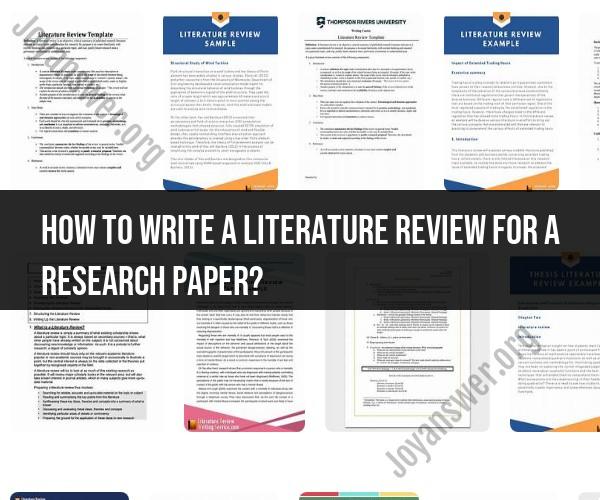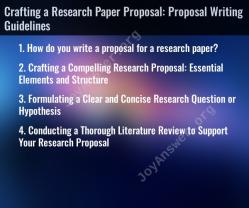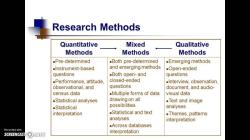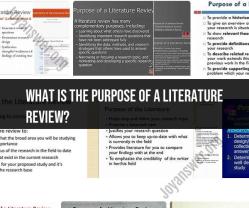How to write a literature review for a research paper?
Writing an effective literature review for a research paper involves several key steps and considerations. A literature review is a critical component of your research paper as it provides context, justifies the research, and demonstrates your understanding of the existing body of knowledge. Here's a step-by-step guide on how to write a literature review:
1. Define Your Purpose and Scope:
- Determine the purpose of your literature review. Are you providing an overview of the research in a particular field, evaluating existing studies, identifying gaps, or supporting your research hypothesis? Define the scope of your review, including the time frame and the specific research question or topic.
2. Conduct a Comprehensive Search:
- Use academic databases, libraries, and search engines to find relevant scholarly sources. Ensure you include peer-reviewed articles, books, theses, and other credible publications. Be systematic in your search, using relevant keywords and phrases.
3. Organize Your Sources:
- Create a system for organizing your sources, such as using reference management software or creating an annotated bibliography. This will help you keep track of the sources you've reviewed.
4. Review and Summarize:
- Read each source critically, extracting key information such as the research methods, findings, and contributions. Summarize each source in your own words. Make clear notes of the main arguments and key findings.
5. Identify Themes and Trends:
- As you review and summarize sources, look for common themes, trends, and patterns in the research. What are the main issues or debates? Are there areas of agreement or disagreement in the literature?
6. Evaluate and Critique:
- Assess the quality and reliability of each source. Consider the credibility of the authors, the research methods, and the validity of the findings. Identify any methodological limitations in the existing research.
7. Provide a Historical Overview:
- Offer a brief historical context or background information about the research topic. Discuss how the field has evolved over time and what key studies have contributed to the current understanding.
8. Synthesize and Organize:
- Organize the reviewed sources into themes or categories based on the commonalities you've identified. Present a coherent narrative that flows logically and helps the reader understand the evolution of the topic.
9. Highlight Gaps and Controversies:
- Point out gaps in the literature where further research is needed. Discuss any unresolved debates or contradictions in the existing research.
10. Connect to Your Research:- Explain how the existing literature relates to your research question or hypothesis. Make a clear case for why your research is important and how it addresses a gap or contributes to the field.
11. Write Clearly and Coherently:- Write your literature review with clarity and coherence. Provide transitions between paragraphs and sections to guide the reader through the review. Use proper citations and referencing throughout.
12. Revise and Proofread:- Review, revise, and proofread your literature review to ensure it is free from errors and is well-structured.
13. Cite Properly:- Ensure that you cite all the sources you've used in your review accurately. Follow the citation style required by your institution or research paper guidelines.
14. Seek Feedback:- Have peers, mentors, or advisors review your literature review and provide feedback.
Remember that a well-structured and well-researched literature review not only adds depth to your research paper but also demonstrates your ability to engage with existing scholarship and contribute to the academic conversation. It should be a balanced synthesis of existing knowledge and a foundation for your own research.
Introduction to Writing a Literature Review for Research
A literature review is a critical summary of the existing research on a particular topic. It is an essential part of any research project, as it allows you to position your own research within the broader context of the field.
Purpose and Significance of a Literature Review
The purpose of a literature review is to:
- Identify the major themes and debates in the field.
- Summarize the key findings of previous research.
- Identify gaps in the literature.
- Develop a theoretical framework for your own research.
A well-written literature review will demonstrate your knowledge of the field and your ability to synthesize and analyze existing research. It will also help you to identify the most important contributions that your own research can make.
Structuring Your Literature Review
The structure of your literature review will vary depending on the subject matter and the length of your paper. However, most literature reviews follow a general structure:
- Introduction: This section provides a brief overview of the topic and explains the purpose of the literature review.
- Body: This section summarizes and analyzes the key findings of previous research. You should organize your discussion by theme or subtopic.
- Conclusion: This section summarizes the main points of the literature review and highlights any gaps in the research. It should also explain how your own research will address these gaps.
Conducting a Comprehensive Literature Search
The first step in writing a literature review is to conduct a comprehensive literature search. This involves identifying and reviewing all of the relevant research on your topic. You can do this by searching academic databases, such as Google Scholar and PubMed.
When searching for literature, be sure to use a variety of keywords and search terms. You should also consider searching for literature in different languages.
Synthesizing and Analyzing Existing Research
Once you have identified the relevant literature, you need to synthesize and analyze it. This involves identifying the key findings of each study and explaining how they relate to your own research. You should also evaluate the strengths and weaknesses of each study.
When synthesizing and analyzing research, it is important to be objective and to avoid presenting your own opinions as facts. You should also be clear about how the research that you are reviewing supports or refutes your own research hypotheses.
Conclusion
Writing a literature review is an important part of any research project. By following the tips above, you can write a literature review that will demonstrate your knowledge of the field and your ability to synthesize and analyze existing research.












